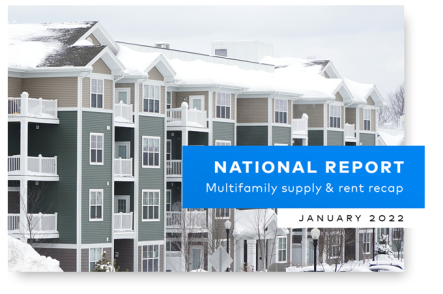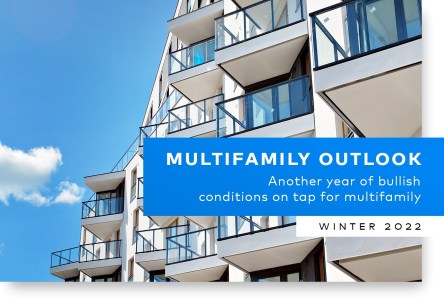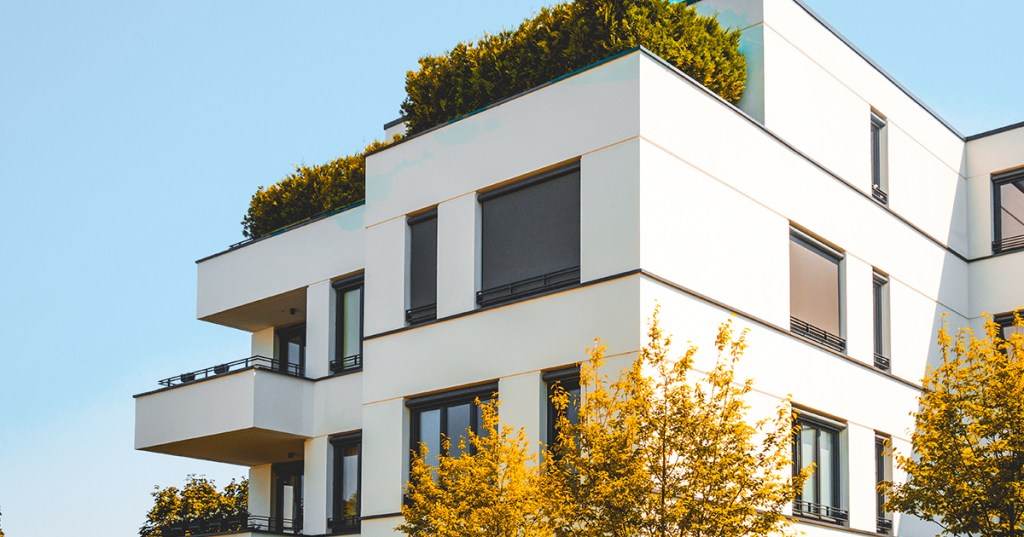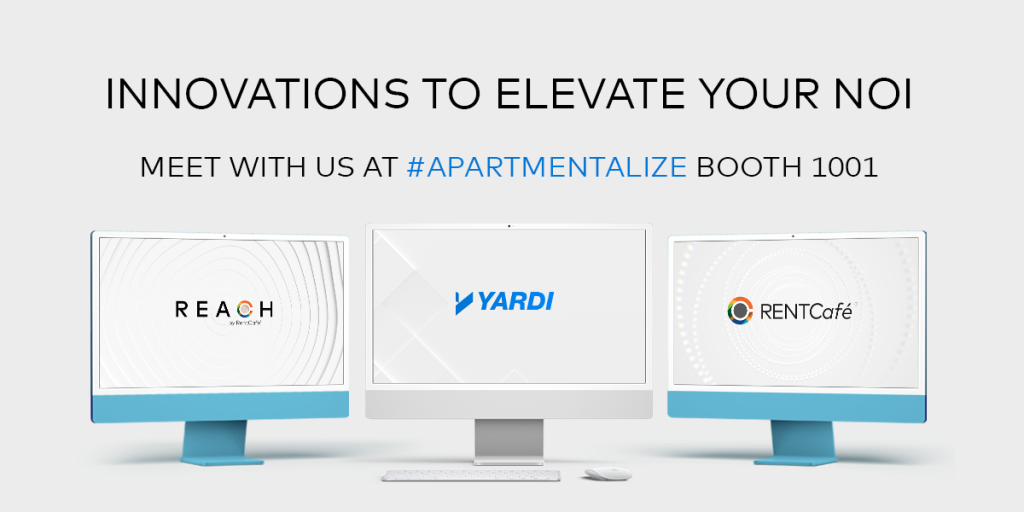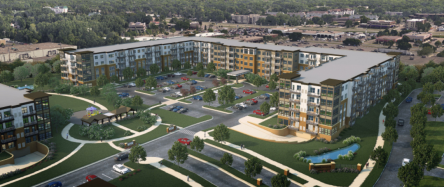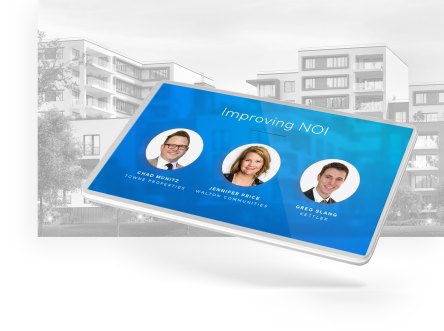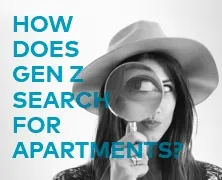Multifamily asking rent gains continued in January, rising $8 to a U.S. average of $1,604, according to the latest Yardi Matrix Multifamily National Report. The latest gain defied normal seasonal expectations and continued a trend established last year, a historic period for multifamily asking rent growth. Year-over-year, rents increased 13.9 percent. While rents are unlikely to remain in that growth range throughout 2022, January’s performance is a sign that demand remains healthy. Some 460,000 multifamily units were absorbed in 2021, according to Yardi® Matrix data, more than double the previous year and more than 50 percent above the previous annual high. Absorption in 2021 was led by Dallas and Houston. Five of the next six highest performers were gateway metros Miami, New York, Chicago, Washington and Los Angeles, all of which absorbed some 20,000 units or more. Freddie Mac’s 2022 multifamily outlook sums up the market: “The strong economic conditions along with unprecedented levels of demand for multifamily housing have combined to create robust apartment market conditions in 2021,” the report said. “While there are still uncertainties, such as increasing inflation or more transmissible variants of the COVID-19 virus … the multifamily market is expected to be on solid ground in the short term.” Learn more in the latest Yardi Matrix Multifamily National...
Rapid Onboarding
With Yardi Aspire
Could your leasing office staff use additional support? Recent data suggests that industry turnover remains high. And while hiring is on the rise, it still falls short of expectations. If your current team members are burning the candle at both ends, thorough and efficient training of new hires is of the utmost importance. Get your team the support it needs. Read on to learn how you can shorten the time between hiring and training completion without cutting corners. Growth for multifamily operations The Bureau of Labor Statistics reported at the end of the year that employment rose by 210,000 jobs. While the growth is notable, it is also falls short: the number of employed persons is still 3.9 million below its pre-pandemic level. Within the industry, growth comes in small increments. Multifamily residential property managers witnessed job growth by 0.58% from November to December. Employment for residential property managers increased by 3.7% year-over-year. In leasing, employment rose by 0.03% month-to-month and 0.67% year-over-year. Though the overall figures fall short of pre-pandemic levels by 2.6%, the uptick in hiring holds promise. Job growth in apartment operations indicates that onboarding procedures will also be on the rise, offering relief to site staff. Tools for easier onboarding Recent new hires offer much-needed support for site staff. The tasks of training and mentoring, however, can make the transition burdensome to existing teammates. Ease the onboarding process with self-guided and role-specific online training. Online learning management software offers secure 24/7/365 remote access to training materials. Learners benefit from the ability to learn at their own speed and review content as needed. Each lesson can include learning checks to assess strengths and opportunities. For optimal efficiency, automatically distribute role-based learning plans. Plans may cover multiple competency areas, including Yardi software...
Canada Multifamily Report
Now Available for Download
Yardi has launched a quarterly report series designed to help Canadian multifamily industry professionals measure portfolio performance, optimize property management and identify investment opportunities. The Canadian National Multifamily Report analyzes vacancy rates, rent growth and other industry fundamentals from data at the national, provincial and Census Metropolitan Area levels. The first edition was released this month. The inaugural report indicates promising signs for the Canadian apartment industry in 2022. Demand remains robust due to the national immigration plan along with gross national product and total employment figures in 2021 that exceeded those seen before the onset of COVID-19. In-place rent averaged $1,326 nationwide as of December, 2.1 percent higher than the same period the previous year, according to the report. Fourth quarter year-over-year in-place rent growth leaders for new leases were London, Winnipeg, Kitchener-Cambridge-Waterloo, Vancouver and Hamilton. Nationwide vacancy in the final quarter was 3.8 percent and slightly trailed pre-pandemic levels. Last year’s strong rent and vacancy performance “was highest in smaller CMAs, as migration out of large cities drove demand in smaller markets,” the report says. The report also notes headwinds to watch for, including inflation, potential Bank of Canada policy rate increases and supply chain bottlenecks. “The Canadian Multifamily National Report presents a new dynamic resource for the real estate industry. We look forward evolving the data to help influence decision-making and innovation across the country,” said Peter Altobelli, vice president of Yardi Canada Ltd. Get your copy of the first Canada National Multifamily...
Online Payments
How to Boost Enrollment
Online payments offer benefits for renters and site staff such as convenience and lower costs. But before you can reap the benefits, you’ve got to get residents to enroll. We’ve got a few quick tips to make the process easier. Online payments add value for residents Per the National Apartment Association, about 78% of residents prefer to pay their bills online. Renters value the convenience of 24/7/365 access to their accounts. And they can submit payments at any time, rather than working within the confines of leasing office hours. Additionally, each online method reduces the risks and data entry associated with cash as well as the hassle of ordering, writing and waiting on paper checks to process. Online payments offer a variety of payment methods to fit your residents’ preferences. Bank account, credit or debit card ACH transactions may occur on single and reoccurring basis. TextPay and voice payments via Resident Services: Alexa Skill are added conveniences. All payment options are easily accessible through your RENTCafe resident portal, which adds value for your renters. More than 92% of respondents consider online rent payment an important resident portal feature. Optimize staff hours with online payments What can your staff accomplish in a workweek without opening mail, scanning checks, trips to the bank, or data entry? Much more. They can nurture new leads and promote retention by building rapport with residents. Both skills bolster your bottom line far more than tedious and redundant tasks like data entry. When you increase adaptation to online payment processing, everyone wins! But first, you’ve got to get renters to enroll. Check out these five tips to boost online payment enrollment. Create an awareness campaign including emails, social media posts, and print posters at the leasing office (especially near the rent...
Multifamily Outlook
Winter 2022
The multifamily market appears poised for another solid year in 2022, according to the U.S. Multifamily Outlook for Winter 2022, released today by Yardi® Matrix. While the record-setting rent gains recorded in 2021 are not expected to repeat this year, analysts anticipate demand for apartments will remain robust, highlighted by strong economic growth and household formation. Investor activity is also expected to continue apace, as capital conditions look favorable and multifamily traditionally offers stable income and low mortgage rates. Powering the positive outlook is the continued strength of the economy and consumer demand. “The economy is benefiting from lingering monetary stimulus, job growth, higher wages and consumer wealth, while supply-chain issues have continued into 2022. Inflation and the labor shortage are the biggest headwinds, but most of the negative ramifications from those matters won’t be felt until 2023 or later,” states the new report. Asking rents rose 13.5 percent nationally in 2021. Anticipated rent growth for 2022 is less than 5 percent, according to Matrix. Economic growth is also expected to step back from the roughly 6 percent increase it recorded last year. Concerns about oversupply have also so far proven to be unfounded and builders are ramping up for new projects nationwide. As of the beginning of 2022, more than 750,000 market-rate apartment units were under construction, with about half expected for delivery this year. Learn more about what’s expected for multifamily in 2022. Yardi Matrix offers the industry’s most comprehensive market intelligence tool for investment professionals, equity investors, lenders and property managers who underwrite and manage investments in commercial real estate. Yardi Matrix covers multifamily, student housing, industrial, office and self storage property types. Email [email protected], call (480) 663-1149 or visit yardimatrix.com to learn...
Multifamily CRM
What to Look For in 2022
Are you setting fresh, ambitious goals for your multifamily business? Quality customer relationship management (CRM) software can help you reach them. We’ve got top insights in what to look for when choosing a multifamily CRM solution. What is multifamily CRM? You’ve likely heard of CRM and even dabbled in some of its features. Such software is increasingly critical for the optimal efficiency and functionality of your multifamily business. CRM gives you a 360-degree view of your relationship with each contact, from prospect to former resident. It offers a centralized location for managing client info, tracking correspondences and compiling data on client behaviors. With such insights, you can market for more conversions, sign more leases, improve retention and revenue. A good CRM tool will also help office workloads feel lighter, resulting in more energized and focused staff with less turnover. If that sounds good to you, read on! What to look for in multifamily CRM… There are lots of CRM options on the market. To select the one that is appropriate for your business, consider the following. Scalability Different tools at different price points will offer options that are suitable for your business. Select an option that meets your current needs and can grow with you in coming years. Automation We will spend a lot of time here. Your staff will need automation to streamline workflows and reduce manual, redundant and often time-consuming tasks. Consider follow-ups: quick responses (under five minutes) are 21 times more likely to lead to a sale. This is because 88% of consumers expect a business to respond to their inquiry within 60 minutes. More than 30% expect a response in 15 minutes or fewer, per the 2020 NMHC/Kingsley Apartment Resident Preferences Report. With automated text messaging and emails, your CRM...
Fitness Trends 2022
Value-add amenities
With the new year here, you can expect an influx of interest in your fitness amenities. Prepare your space and gym calendar for creative, fun and forward-thinking fitness opportunities. You can appeal to prospects who are seeking a fresh start as well as existing renters. Refresh your fitness center offerings Among New Year resolutions, wellness goals top the list. Whether it’s someone pursuing a healthier lifestyle or the fitness fanatic seeking greater gains, your gym is a tool for resident satisfaction. For the greatest satisfaction, regularly refresh your offerings. Without new and exciting options year-round, you’ll experience periods of frequent use and periods of gathering cobwebs. For exciting fitness ideas, take inspiration from these fitness trends for 2022. Fitness industry trends for 2022 1. Hybrid classes Offering in-person, virtual live stream, and on-demand recordings is a great way to appeal to busy renters. The array of options gives them the opportunity to work out in any manner and at any time. Follow-along videos are also a creative way to disperse crowds at the fitness center. When renters know they can access guided classes online, there is no need to max out in-person classes. 2. Sync with wellness trackers If you’re renovating, adding or updating your equipment, seek options that correspond with multiple fitness trackers. This feature makes coming to your gym an integrated part of residents’ wellness plan. 3. Outdoor classes Outdoor classes offer a convenient way for residents to exercise in a well-ventilated space. Additions such as solar sails and fans can extend the usefulness of your outdoor fitness area. 4. Love low-impact options Consider using the community pool to offer low-impact cardio and strengthening options. Buoyancy is a great tool for renters who are new to movement, suffer from joint pain,...
Leveraging Tech
Discussion at ONPHA
Technology has the power to transform our work and our lives. During the Ontario Non-Profit Housing Association (ONPHA) conference, Yardi sponsored and moderated the session, Impactful Innovation: Leveraging tech to gain visibility and empower your teams. Meherzad Bakht, senior account executive at Yardi Canada Ltd. moderated the panel attended by Kelly Black, chief administrative officer, District of Timiskaming Social Services Administration Board (DTSSAB), Clinton Reid, quality assurance and compliance manager, Woodgreen Community Centre and Abdulle Elmi, business lead, Housing Management Enterprise System (HoMES) at Toronto Community Housing Corporation. The live virtual event explored solutions that can help organizations improve oversight and visibility into their facilities and operations, elevate resident management and tenant care, and inspire diverse teams and drive efficiencies. Here are some of the highlights from the discussion. The quest for change Different factors served as catalysts for change within their organizations. Two consistent threads emerged: front-line staff endured repetitive, time-intensive manual tasks that often resulted in inefficiencies and inconsistencies; and disparate systems resulted in murky reporting and limited data analysis. The organizations sought for a way to streamline reporting, requiring fewer employees to spend less time identifying a single point of truth. Reid explained, “When we communicate to leadership that we can get the job done, we neglect to convey the amount of time and effort required to pull and complete a report.” He continues, “When COVID hit, we realized the number of resources put into reporting was significant.” All three organizations experienced some resistance at the ground level. Staff were leery of learning complex software that didn’t completely meet their needs or understand the social housing reporting requirements. The request to document processes also resulted in a sense of unease, though leadership assured their teams the efforts would ultimately support and simplify their work. Elmi said,...
Loyalty + Retention
Supporting Resident Mental Health
If you could help make the holidays less difficult for your residents, would you do it? Grief, stress, loneliness, social anxiety and financial struggles can be particularly heightened during this time of year. Through supportive services and resources, you can aid residents during the holidays with tools that you already have on hand. Resident loyalty is solidified through the human-to-human connection Research confirms that developing a sense of community adds value to housing. Residents who feel integrated into their communities are more likely to renew their leases, which saves you time and bolsters your bottom line. The suggestions below can help residents feel welcomed and supported during difficult times. They show that you care because you do care! As a bonus, your efforts will not go unnoticed when it’s time to renew the lease. Resident retention improves your net operating income while giving you warm, fuzzy feelings for the holidays! Read how you can promote resident retention through culture and branding. Encourage residents to move with you to address the symptoms of stress, depression and loneliness Consider hosting group fitness classes and wellness events at your property. Physical movement releases feel-good hormones called endorphins. Endorphins interact with the brain receptors that decrease the reception of discomfort. They also reduce the stress hormone cortisol. Certain types of movement can also soothe the nervous system. For indoor options, restorative yoga, yin yoga, tai chi and qigong are methods of movement that activate the parasympathetic nervous system. This system of the body promotes physical and mental recovery, healthy digestion and helps the body to relax. (As the nation continues to navigate the pandemic, some residents may not be comfortable in indoor group activities. Consider setting up a camera on the instructor so that they can lead both...
2022 Forecast
Top Performing Markets
Wouldn’t it be terrific to predict the future of real estate performance? We’re not quite fortune tellers (yet), but analysts have optimized predictive analytics. Data gives us insights into major shifts, empowering real estate pros to navigate decision-making accordingly. Today, we’re taking a look forward into the hottest markets for real estate in 2022. No, growth isn’t dominated by the same old major metros For years, large cities like Los Angeles and New York reigned supreme on the hottest markets lists. High rents, low vacancies and a steadily growing interest in convenient urban living made major metros desirable destinations. While major metros still have their appeal, remote work has enabled significant portions of the population to work from anywhere in the nation. Their sights shifted to secondary and even tertiary markets as people sought a lower cost of living. In such markets, dollars go further and gain more square footage in both multifamily and single-family options. The 43rd Emerging Trends in Real Estate report issued by PricewaterhouseCoopers (PwC) ranks the following cities as the hottest markets in 2022: 1. Nashville2. Raleigh/Durham3. Phoenix4. Austin5. Tampa/St. Petersburg6. Charlotte7. Dallas/Fort Worth8. Atlanta9. Seattle10. Boston Who thought we would see the day when cities like Raleigh would usurp San Diego, or Charlotte to outpace New York? These are strange and exciting times. Is there anything standing in the way of ongoing growth for smaller markets? Sometimes, trends are just trends. They are blips on the radar that you can navigate with or around and emerge on the other side of history nonplussed. But are the hottest markets for 2022 a trend, or are they the beginning of an entirely new dynamic in real estate? The PwC report indicates that, “flexibility and convenience drive the next decade” in real...
Amping Up Amenities
Property Owners Think Big
Amenities like fitness centers, laundry rooms and pet services are standard at many residential and commercial properties. So ordinary are they that property managers are striving to deliver increasingly elaborate offerings to attract residents and tenants. Real estate investment information source Millionacres.com says, “If you want your units to fill up quickly and stay filled, you’ll want to offer the best apartment amenities possible for your tenants.” That doesn’t just mean rooftop pools, private restaurants, pet spas and indoor skate parks for high-end space. “Desirable amenities can be offered at smaller properties, too.” Dog grooming services can be a plus for pet owners. As for commercial space, San Diego commercial real estate investment firm Locale notes, “Spare corner weight rooms have transformed into fully equipped, professionally staffed fitness centers; the corner coffee cart has evolved into a chic, onsite café complete with baristas serving specialty coffee; and outdoor seating areas have expanded to include meditation gardens, dog runs, and sports fields.” Residential: Exceeding the expected As Millionacres and other property management industry observers suggest, owners and managers might want to consider stepping up their game for residents who expect: More than just enough space for parking and bikes. Service enhancement options include assigned off-street parking with additional spots for guests and bike storage, and electric vehicle charging-equipped garage parking.A larger welcome mat for Rover. Consider expanding the pet-friendly policy with a dog park or grooming\spa services.Energy efficiency. Many tenants seeking sustainability and cost savings opportunities expect upgrades like compact fluorescent lamps instead of incandescent ones, solar panels or fuel cells rather than grid-based fossil fuel power with, LEED certifications, and ENERGY STAR® certifications for refrigerators and other appliances that meet stringent energy-efficiency standards.Better building heating and cooling systems, featuring central air and heating systems...
Health + Home
Supporting Residents through the Holidays
Did you know that our home environment impacts how we feel? During the holidays, multifamily professionals can increase the perceived value of the property while supporting resident wellbeing and promoting resident loyalty. It all starts with decorating. Drive value while helping residents fall in love with your property again Resident retention saves time and money. Per the National Apartment Association, it costs between $1,000 to $5,000 to turn a unit. If you gained just one renewal each month, you could save $20,000 in annual expenses and about 96 hours of maintenance labor. Promote resident retention through thoughtful programming that shows residents that you care. This includes special programming to support residents who are struggling through the holiday season. Design programming can be a great place to start. Design to beat winter blues together Nearly 40 million Americans experience depression and anxiety, reports the Anxiety and Depression Association of America. The fall and winter seasons are especially challenging. The American Family Physician reports that up to 26% of Americans suffer from seasonal affective disorder (SAD) formerly called seasonal depression. Scientists note a correlation between less exposure to sunlight (vitamin D), decreases in serotonin and an uptick in melatonin. Those factors may exacerbate existing conditions around holiday social and financial stresses, loneliness and grief. Community managers are not clinicians. There are several resident services that community managers can offer, however, to support resident wellbeing during the holidays. Focus on fun yet effective services that turn resident homes into mental health havens. Host healthful interior design classes Consider inviting a healthy interior design expert to speak to your residents. The American Society of Interior Designers has representatives nationwide. You might also research environmental psychologists in your area. These specialists understand how our built environments can impact our...
Renting to Leaders
Multifamily Prepares for Gen Z
Is your property ready for Gen Z renters? Gen Z has different housing expectations than any generation before them. A new study reveals their unique interests and goals. Renting to Gen Z requires appealing to their mindset. This may lead to a significant shift in how we view floor plans, services and amenities. Gen Z is already old enough to rent?! It’s true. The generation that feels like it was born 10 years ago is now entering adulthood. Members of Generation Z were born between 1996-2012 which means the earliest members are among your current prospects. This generation of 67 million people is one of the most racially and ethnically diverse to reside in the U.S. That suggests that there is a broad pool of features and amenities to keep in mind when renting to Gen Z — but there are a few unifying threads among the masses. Gen Z: a generation of leaders In the “Meet Gen Z” infographic created by REACH by RentCafe, it cited data from Dan Schawbel which revealed that 81% of Gen Z aspire to be leaders. Specifically, 41% plan to be entrepreneurs. These data points suggest that many of your future residents will have big pursuits and their home must reflect their goals. To use this information to your advantage, think of services and amenities that cater to the entrepreneurial mindset. How might you enhance your business center? Might you transform a common space into an on-premises coworking center?Could you enter a mutually beneficial contract with a nearby coworking space?Might you build community through a local group for leaders and entrepreneurs?What events could show that you understand who they are? What local leaders or entrepreneurs might you invite to speak at events for your residents?How will your...
DIY SEO
For apartment marketing
Search engine optimization: You know you should be doing it, but are you taking proactive steps to optimize your apartment marketing website? By now, the benefits of SEO for apartment marketing are clear. By optimizing your site, you make it more attractive in search, both to search engines and potential customers. When search engines like your website, they think it is trustworthy and answers relevant search terms. When customers like your website, they engage with it by visiting multiple pages and clicking buttons. Relevance and engagement cause your site to rise higher in search results, helping you build authority, reach more potential renters and fill more vacancies. Property management SEO may seem like an overwhelming responsibility. After all, every time there’s a significant algorithm change, new articles come out with tips and tricks designed to adapt to the changes. But what you might not realize is that SEO is intended to be more or less straightforward. If your website creates a good user experience by functioning well for all visitors and providing valuable information for your target audience, it should appear in search results. And for apartment marketers, the search results that matter are typically local ones e.g., “one-bedrooms in <city>” and “<neighborhood> apartments for rent.” With that in mind, here are a few DIY SEO tips for apartment marketing. Start making these updates today to see positive results in the long term. Optimize the metadata for every page Every page of your website should have an optimized title tag and a metadata snippet. This is what will show in search results. Google measure title lengths in pixels, not characters, but per Moz, it’s a good idea to keep your title between 50-60 characters. Meta descriptions can be any length, but Google generally truncates...
Returning to Cities
Will SFR growth stall?
Single-family rentals (SFR) are currently thriving. Last year alone brought $8 billion in new investments, and activity through this year exceeds that pace. Activity is especially rapid around the metros of the southeast and interior U.S. The regions’ low taxes and high land availability attract developers while renters enjoy the low cost of living and a higher quality of life. But can the SFR market growth last as Americans return to the cities from which they fled? What caused the boom in single family rental popularity? The popularity of SFR is threefold. The industry has been steadily gaining momentum since the onset of the Great Recession. Empty nesters composed a significant demographic of early adapters. They aimed to downsize and decrease maintenance without losing the private space they’d grown to love. Millennial families with freelance jobs or with telecommuting options made up the second largest faction of renters in single-family homes. Fast forward about a decade and single-family rentals received another boost in demand. The pandemic served as a catalyst for the recent spike in interest as many Americans opted to leave congested cities for roomier suburbs. Small scale investors made up the bulk of property owners in 2018. By 2020, the landscape began to change. In addition to mom-and-pop operations, builders quickly gained interest in rental assets. Analysts estimated that the pandemic accelerated built-to-rent space by 5 to 7 years. About 10% of SFR are now built-to-rent properties and 12% of current single-family construction is designated for rentals. Trepp reports that 2020 was the most active year for SFR securitizations in U.S. history. New issuance topped $8.3 billion, about a 99% increase from 2019 and a 9% increase from 2018’s previous record-high. Into mid-2021, Trepp recorded $3.1 billion worth of newly securitized SFR...
Renters Still on the Move
Matrix Multifamily Webinar
With the future of office-based employment still in flux for millions of Americans, the multifamily industry continues to see dramatic shifts in where renters are living, as well as rent increases that have yet to be fully factored into the nation’s inflation calculations. Summer and early fall of 2021 saw dramatic increases in multifamily asking rents, a growth trend that Yardi Matrix vice president Jeff Adler called “a barnburner” in this week’s webinar analyzing the sector’s recent performance. However, rent growth is expected to temper in the final months of 2021. “We have really seen a shifting and reallocation of population due to remote work,” Adler stated. “This is the American people solving a (housing) supply problem in the most expensive areas. They are now able to take their paycheck with them and move to less expensive areas.” View the presentation and find slides on yardimatrix.com. At the outset of the presentation, Adler encouraged multifamily investors to develop a strategy that considers the future of office-based employment. Instead of workers going back to the office in droves this fall, the summer Delta variant surge delayed and, in some cases, derailed office reopenings. Some jobs, like financial and government roles, require onsite security and can’t be done remotely. The technology industry is expected to lead fully remote and hybrid opportunities. “Work is now not somewhere you go, but something you do,” Adler said. That ongoing transformation will continue to play out over the next two years. “It’s not going to go back to the way it was, and neither are offices going to be irrelevant.” Economy still in transition phase Meanwhile, the U.S. economy has been struggling to recover from the pandemic. Supply chain issues as well as reduced employment, especially among Americans age 55 and up, are prompting widespread inflation issues that seem likely to persist for the near-term. Yardi Matrix has revised its inflation outlook since the last multifamily webinar was held, Adler noted. And one indicator that inflation may get worse before it gets better is that rent increases are a trailing indicator and have yet to make their way into Consumer Price Index (CPI) calculations. “The Fed (Federal Reserve) story has been that inflation is transitory, but it’s not looking that way to us as an organization,” Adler stated. He noted that had the projections of transitory inflation been accurate, they should have been resolving right about now. Instead, inflation continues to rise. “There is a lot of dry powder in terms of consumer spending. This is a case of too much money facing too few available goods,” Adler explained. Available cash has helped fuel consumer purchases (buoying industrial real estate) and relocations (increased rents in multifamily and high demand for self storage.) “Everything you used to know about inflation has been upended,” Adler said. “I think we will see recovery in services inflation, but an expansion of (cost of) goods inflation. And we haven’t seen the increased rent impacts flow through inflation metrics yet.” High demand for tech hub housing + single family rentals High demand for coveted housing markets, especially in tech hubs like Austin, Denver, Las Vegas, Nashville, Orlando, Phoenix, Raleigh-Durham and Seattle, has driven prices up and availability down in those cities. Meanwhile development is returning and Matrix has revised its anticipated unit delivery target from 350,000 multifamily units per year to 400,000. An especially hot subset of the multifamily market is single family homes that are build-to-rent (BTR), which are driving increase suburbanization of the rental space. Some renters are turning to the BTR option because heightened home prices have put down payments out of reach. BTR homes currently make up 5-10 percent of new home stock, according to the U.S. Census Bureau. And they’re expected to grow dramatically, with $30-40 billion in capital currently designated for the BTR space, Adler said. However, don’t assume that it’s families with kids trading...
Yardi at Apartmentalize
Get the Details
Chicago has reopened, and Apartmentalize powered by NAA will be there at McCormick Place from Aug. 31-Sept. 2 to bring forward-thinking multifamily operators from across the country and leading solution providers together. Yardi will return as a proud top tier partner, presenter and exhibitor. Read on for everything you need to know about this year’s event. See our innovative proptech Don’t miss the chance to connect with Yardi in person at Apartmentalize 2021. Come to booth #1001 to see our latest protech innovations. We’re excited to show you how our single connected solution will help you visualize performance, reduce expenses, automate interactions and enhance operations to increase your NOI. We will be featuring: REACH by RentCafe: Improve marketing ROI with advanced digital marketing services including SEO, PPC, social media, reputation management and performance analytics. RentCafe: Drive leases and improve retention for higher rental revenue with self-guided tours, a chatbot and smart home services. Yardi Elevate Suite: Combine deep operational data, market intelligence, revenue forecasting and prescriptive analytics to optimize asset performance and increase NOI. Introducing Yardi Breeze Premier: Our intuitive and powerful property management software is making its industry debut at the show. Boost performance with an easy-to-use, all-in-one marketing, management and accounting system. Reserve a private demo to see any or all of our proptech innovations that will take your business forward. Learn with us Yardi leaders will be participating in four educational sessions to share insights on hot industry topics and trends. Take advantage of these opportunities to deepen your industry knowledge and improve your operational strategies. Meet Gen Z: Understanding the Next Generation of Renters | Aug. 31, noon-12:45 p.m. Join Esther Bonardi, vice president at Yardi, as she leads a panel on Gen Z renter preferences with Garin Hamburger, senior director of national property marketing at Cushman & Wakefield, and Brooke Atsalis, marketing and training manager at The Management Group, LLC. Over 40,000 survey responses will help you get to know Gen Z through the data. Review shifting search trends, examine touring preferences and discover five tech must-haves. Learn how to adapt your property marketing strategy and shape your future success as we prepare to welcome a new generation home. Emerging Issues: Inflation and Its Effect on the Industry | Aug. 31, 1:15-2 p.m. NAA’s AVP of research, Paula Munger, joins industry experts, Jeff Adler of Yardi Matrix and Jay Parsons of RealPage, to discuss price trends, their impact on the economy and the industry, and what we can expect for the remainder of another very strange year. How will it affect the industry and how much sleep should you be losing over it? How Universities’ COVID-19 Decisions Impact the Student Housing Industry | Sept. 1, 3:45-4:30 p.m. Join Jeff Adler and Chris Nebenzahl of Yardi Matrix for a discussion on fall 2021 pre-leasing and how it compares to prior years. They’ll discuss rent growth in a post-COVID world, new development of purpose-built student housing, how universities have handled the pandemic from operational and housing perspectives and future plans for the industry. Myth Busting: Case Studies Debunking Affordable Housing Online Application Process | Sept. 1, 3:45-4:30 p.m. Geared towards affordable housing operators, Yardi vice president Christopher Voss joins Dawn Ford of Smart Apartment Solutions and Smart Moves, Phyllis Garcia of Ovation and Shay Dugan of TM Associates as they talk about the need for conducting business online and the perceived barriers considered unique to the affordable housing market. Pick up tools and possible solutions, such as low cost/no cost and easily accessible platforms that smash the myths that technology cannot exist in the application processes. See the complete Apartmentalize schedule for more information. Can’t make it this year? Not attending Apartmentalize 2021 but want to learn more about our solutions? Check out the Yardi Multifamily Suite, join a webinar or contact us with any...
Dominium Expansion
Minnesota Affordable Housing
Minnesota will soon have more affordable housing options. Plymouth-based developer an Yardi client Dominium selected a 5.2-acre parcel in Roseville for its newest affordable project. The market is ripe for new development, with recent average vacancy rates hovering around 2.2%. A local average rate of 5% is typical in a balanced market. The Harbor at Twin Lakes will be a senior affordable housing community. It will offer 277 units including 131 one-bedroom units, 116 two-bedroom and 30 three-bedroom units. The units are divided between five floors within a single building. Photo courtesy Dominium The rent-restricted neighborhood will accommodate residents aged 55 and over who earn 50% of the area median income or below. Exploring the neighborhood near The Harbor at Twin Lakes The Harbor at Twin Lakes will be a walkable community with access to shopping and dining. The community includes seven commercial properties, surface and underground parking. Just eight miles from Minneapolis and 10 miles from downtown Saint Paul, the community is conveniently located near several local attractions. The Harbor parcel, located at 2730 Herschel St., is part of the larger Twin Lakes Station redevelopment. It rests adjacent to Oasis at Twin Lakes, an affordable housing community with 228 units. The units are divided between two low-rise buildings. Construction on the $74 million Oasis project began in July 2020. It is scheduled for completion in 2022. “Dominium is very excited to announce this new development as it will provide much-needed high-quality affordable housing in the Twin Cities metro,” said Dominium Vice President and Project Partner Ryan Lunderby. Financing The City of Roseville has provided a $35 million bond for the development of The Harbor. Tax-exempt financing, once offered by Greystone, is now managed by Freddie Mac. The property is also funded in part...
Gen Z
Ratings & Reviews
The tech-savvy members of Gen Z are no strangers to browsing and shopping online. As a generation with high expectations, ratings and reviews are a large part of their online buying process. But just having ratings and reviews isn’t enough to win their business. You have to be strategic if you want to stand out from the competition. REACH by RentCafe is digging into how Gen Zers use ratings and reviews. This information will help you figure out how to achieve glowing ratings from your young renters. Why are reviews important? Before jumping into how Gen Zers use ratings and reviews, it’s important to first understand just how essential this aspect of your business is. For one, reviews help potential customers gauge an item or service’s quality while simultaneously informing your business about what works and what could be done differently. Additionally, reviews improve your search rankings. Did you know that, without them, there’s no chance of showing up in the Google local pack? Lastly, and perhaps most importantly, reviews increase the likelihood of conversion, and isn’t that the goal of your digital marketing strategy? Ratings and reviews inspire customers to reach out to you, increasing the probability of them converting. RentCafe.com conducted a study of all the apartment search journeys that resulted in a lease and found that ratings and reviews were one of the top three features that lead to conversions. When you’re looking to draw in Gen Z renters, ratings and reviews are a critical part of the marketing process. How do Gen Zers use ratings and reviews? As part of a survey series with more than 10,000 Gen Z participants, 65% of Gen Zers say they consider ratings and reviews always or most of the time when searching online. This...
Tech for the Win
Ops and Your Bottom Line
If you’re like many multifamily operators, the technology you thought would be “nice to have” became “must have” when COVID-19 hit. With those must-have contactless services and automated transactions in place, companies are now asking, “what’s next?” to move business forward. To answer that question, we talked to Chad Munitz, vice president of development at Towne Properties, Jennifer Price, director of systems at Walton Communities, and Greg Slang, executive vice president of asset management at KETTLER, about the metrics they’re focusing on in 2021, and how it’s shifted the way they do business. The bottom line: They can still improve net operating income beyond rent increases by reducing expenses, increasing efficiencies and leveraging new technology in their operational processes. Keep reading to hear their stories and get some ideas to incorporate in your business. Virtual tours and online leasing According to Munitz, Towne prides itself on being a high touch management company — and technology has increased its capabilities to offer more to its residents. With the onset of the pandemic, Towne quickly provided more contactless services. “When the pandemic started, one of our initial fears was how do we keep those relationships and touches going with all of our residents. It allowed us to figure out the services we wanted to roll out quicker — including allowing people to pay rent online and sign leases digitally. We really started focusing on a centralized leasing and management process and honed-in on some of our urban properties where we were seeing the most negative impacts of the pandemic in terms of revenue. So, we centralized all our leasing and management at one location and implemented technology to support it. We were as in touch with our residents as we were before, and we increased ways...
Gen Z
Online Search Behavior
After first getting to know Gen Z, the team at REACH by RentCafe investigated how this tech-savvy generation searches online so that you can learn the best way to attract these young renters. Gen Zers have developed specific search and viewing habits For a generation that has grown up glued to computers, phones and tablets, Gen Zers have had years to cultivate their online search habits. In a series of 36 video interviews with members of Gen Z, REACH by RentCafe found that participants tended to start their search on Google, and often used long-tail search phrases, averaging 4.9 words per search. This is higher than the overall average of 4.2 words. Additionally, Gen Z tends to favor key words such as “Best,” “Cheap” and “How to” when searching online. Members of Gen Z also spend a lot of their time online watching videos, and they have specific preferences when it comes to which type of clips they like to watch. In a survey of over 10,000 Gen Zers published on rentcafe.com, 69% said they preferred a combination of user-created and professionally produced videos. This generation has come of age online, and as these renters enter adulthood, it’s clear that they are not only fully equipped to navigate the internet, but they’ve also developed a specific way of doing so. Gen Z attention span < goldfish attention span Did you know that with an estimated attention span of just 8 seconds Gen Zers are even less alert than their millennial counterparts (12 seconds) and, yes, goldfish (9 seconds)? In one video interview from the series, Gen Z member Keona spoke about how, when searching online for restaurants, thousands of results could be “overwhelming.” She continued, “I have a very short attention span, and I...
Optimize Rents
4 Tips for Success at Every Phase
At every step of your journey, there are opportunities to elevate your asset performance. Today’s technology can equip you with the tools and insights needed to make the most of every square foot. Read on to learn how you can maximize rents at every stage of your project. Design for density To maximize net rentability, begin with your design. Dense multifamily housing offers more units and the potential to garner more rents. Data from Hanley Wood explores ways to increase density in multifamily, along with the benefits and disadvantages of each methodology. Explore site plans that truly show the relationships between design options and core development metrics. Of the most favorable options, you might: apply for a variance to decrease the setbacks on the site. This relatively simple adjustment can boost your buildable square footage. increase the net rentable square feet (NRSF) by increasing the depth of your units at the desired square footage. In longer runs, you can increase density and the potential for rents. get creative with amenities. When possible, decrease their size and explore options such as an outsourced gym with Amenify or outsourced communal space. With improved density, you help to increase your NRSF and position yourself for greater net rentability. Maximize rents with the latest data If you’re working with a built structure, there are ample opportunities to maximize rents. Implement a program that optimizes the value of your asset using big data, predictive analytics and prescriptive actions. Overall, this approach helps to keep costs low, increase your revenue and mitigate costly operational risks. Consider a solution that allows you to benchmark your operating income and expenses against your competition. Transparency within your portfolio is crucial as well. A robust system synthesizes data throughout your integrated property management, leasing...
NAA Grants
For Multifamily Innovation in Diversity + Inclusion
This is the final week to submit applications for The National Apartment Association (NAA) Innovation in Diversity Grant (IDI). The program aims to advance diversity and inclusion in the rental housing industry through impactful education and hiring practices. NAA seeks to “inspire the next generation and strengthen those whom we work and exist to serve.” To do so, NAA has designated $25,000 per fiscal year towards the IDI grant. NAA member associations, property management firms, supplier partners and related organizations are eligible to apply. Creating a more equitable multifamily industry To qualify, participants are encouraged to align their program objectives with the ideals of the NAA Diversity and Inclusion Vision Statement. Additionally, the proposals must reflect the NAA’s dedication to an inclusive and supportive workforce environment that is rich in diversity. Applicants must propose innovative ideas that will result in meaningful contributions to the multifamily industry. NAA supports projects that fall into three main categories: Education Programs should demonstrate methods to improve diversity, inclusion and awareness within the applicant’s organization. Leadership Programs should enhance the presence of diversity among leadership and boards within their organizations. Such programs may create specialized training tracks for marginalized groups. D&I Projects Programs should bolster the presence of underrepresented groups at all levels in the industry. Opportunities may include but are not limited to scholarships and innovative steps towards more equitable hiring practices. Selecting finalists Applications will be received by the NAA Diversity and Inclusion Committee. Evaluators analyze each applicant’s potential for measurable outcomes, detailed budget, program timeline and support of NAA’s Diversity & Inclusion vision. Home Depot Pro: supporting diversity and inclusion in multifamily housing Home Depot Pro is a proud sponsor of the IDI Grant. The world’s largest home improvement retailer released a statement, stating, “We are...
Rents Rise Nationwide...
New report from Yardi Matrix
Multifamily asking rents jumped an average of 6.3% year-over-year in June, the largest leap ever recorded by Yardi Matrix, a leading industry data tracker. The national average apartment rent increased $23 last month to $1,482, another record, and single-family home rents were up 11% year-over-year. “These are the largest year-over-year and monthly increases in the history of our data set,” said Jeff Adler, vice president of Yardi Matrix. Analysts point to increased household savings and government stimulus funding as factors that have kept the multifamily industry stable during the pandemic period, and now able to rebound as the economy improves. The newly released data is an economic indicator of post-pandemic recovery across the U.S. The largest increases were documented in the lifestyle apartment sector. Renters are also now returning to many gateway markets that saw outbound migration for most of the last year. A supercharged housing market is also pricing out some potential buyers, leading residents to remain in apartments. “Rent growth will not be able to continue at these levels indefinitely, but conditions for above-average growth are likely to persist for months,” Adler said. The increases reflect growth in what landlords are asking for unleased apartments. Renters renewing leases may also be seeing increased rents, but likely at lower levels. Migration is pushing up rents in Southwest and Southeast metros like Phoenix (17.0%), Tampa and California’s Inland Empire (both 15.1%), Las Vegas (14.6%) and Atlanta (13.3%). These metros were lower cost compared to larger gateway metros. Get more insight on the historic report. Yardi Matrix offers the industry’s most comprehensive market intelligence tool for investment professionals, equity investors, lenders and property managers who underwrite and manage investments in commercial real estate. Yardi Matrix covers multifamily, student housing, industrial, office and self storage property...
Gen Z
An important introduction
Step aside millennials, the largest generation ever is ready to rent. The oldest members of Gen Z will ring in their 25th birthdays this year, and this tech-savvy group is quickly becoming the fastest growing renter demographic. Coming of age in the era of smart phones and social media, Gen Zers are highly skilled and have even higher expectations compared to previous generations. By now, you probably know the basics about Gen Z, but as the up-and-coming generation of renters, it’s critical to dig deeper. To appeal to these “digital natives,” you must first understand their habits, values and lifestyles. Lucky for you, REACH by RentCafe is taking a closer look at Gen Z characteristics and will be sharing its research data with you in a series of infographics. But first, let’s understand who exactly these Gen Zers are. Gen Z’s top 3 characteristics Gen Z is made up of independent and entrepreneurial thinkersMost Gen Zers were raised by members of Gen X. As parents, Gen X tend to favor autonomy and entrepreneurialism, values they have passed on to their children. Members of Gen Z celebrate their independence and ability to express themselves, and they don’t have the perception that things will just go their way. They aspire to become leaders, and 41% plan to become entrepreneurs. More than others, this young generation seeks to create success instead of expecting it. Gen Z values diversity and societal changeWhile Gen Z is the largest generation yet — roughly amounting to 2.46 billion people in 2019 — it is also the most diverse. According to the Pew Research Center, in the US, 52% of Gen Zers are non-Hispanic white, 25% are Hispanic, 14% are Black, 6% are Asian and 5% are other.They’ve also experienced and embraced...

